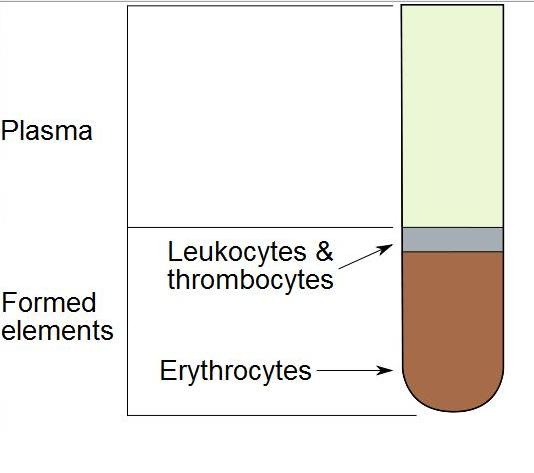Hematocrit

|
WikiDoc Resources for Hematocrit |
|
Articles |
|---|
|
Most recent articles on Hematocrit |
|
Media |
|
Evidence Based Medicine |
|
Clinical Trials |
|
Ongoing Trials on Hematocrit at Clinical Trials.gov Clinical Trials on Hematocrit at Google
|
|
Guidelines / Policies / Govt |
|
US National Guidelines Clearinghouse on Hematocrit
|
|
Books |
|
News |
|
Commentary |
|
Definitions |
|
Patient Resources / Community |
|
Patient resources on Hematocrit Discussion groups on Hematocrit Patient Handouts on Hematocrit Directions to Hospitals Treating Hematocrit Risk calculators and risk factors for Hematocrit
|
|
Healthcare Provider Resources |
|
Causes & Risk Factors for Hematocrit |
|
Continuing Medical Education (CME) |
|
International |
|
|
|
Business |
|
Experimental / Informatics |
Editor-In-Chief: C. Michael Gibson, M.S., M.D. [1]
Overview
The hematocrit (Ht or HCT) and packed cell volume (PCV) are measures of the proportion of blood volume that is occupied by red blood cells. It is normally 45 ± 7 (38-52%) for males and 42 ± 5 (37-47%) for females.
The packed cell volume can be determined by centrifuging. Heparinized blood in a capillary tube (also known as a microhematocrit tube) is typically centrifuged at 10,000 RPM for five minutes. [2] This separates the blood into layers. The volume of packed red blood cells, divided by the total volume of the blood sample gives the PCV. Because a tube is used this can be calculated by measuring the lengths of the layers.
With modern lab equipment the hematocrit is calculated by an automated analyzer and not directly measured. It is determined by multiplying the red cell count by the mean cell volume. The hematocrit is slightly more accurate as the PCV includes small amounts of blood plasma trapped between the red cells. An estimated hematocrit as a percentage may be derived by multiplying the hemoglobin concentration in g/dL times three and dropping the units. [3]. The hemoglobin level is the measure used by blood banks.
The hematocrit is considered an integral part of a person's complete blood count or CBC results along with the hemoglobin concentration, white blood cell count, and platelet count.
There have been cases where the blood for testing was inadvertently drawn from the same arm with the intravenous line running in a transfusion of packed red cells. In this sample, the hemoglobin measurement will be high because it is measuring the fluid being transfused (that is, mostly red cells) rather than the diluted serum. In this case, the hematocrit measurement will be artificially very high.
Conversely, if blood for hematology testing is drawn from a site proximal to that of an intravenous line infusing fluids into a patient, the blood sample will be diluted by those fluids and the hematocrit will be artificially low.
If a patient is dehydrated, the hematocrit may be elevated. Repeat testing after adequate hydration therapy will usually result in a more reliable result.
In mammals, hematocrit is independent of body size.

Elevated hematocrit
In cases of dengue fever, where the full blood count is done daily, a high hematocrit is a danger sign of an increased risk of dengue shock syndrome.
Polycythemia vera (PV) is associated with elevated hematocrit. PV is a myeloproliferative disorder in which the bone marrow produces excessive numbers of red cells, and reflects excessive numbers of RBC precursors in the bone marrow, as well as some abnormal forms. This condition is called erythroid hyperplasia. Excessive production of both RBCs and WBCs is called bilineage hyperplasia, and if there are excessive numbers of platelets also, trilineage hyperplasia. If PV is present, it is not uncommon to see the serum uric acid level elevated, reflecting an increase in the rate of cell turnover, reflecting increased pyridine metabolism.
Another myeloproliferative disorder is called essential thrombocythemia, in which primarily the platelets are elevated in number.
Chronic obstructive pulmonary disease (COPD) and other pulmonary conditions associated with hypoxia may elicit an increased production of red blood cells. This increase is mediated by the increased levels of erythropoietin by the kidneys in response to hypoxia.
Lowered hematocrit
Lowered hematocrit can imply significant hemorrhage (for example, in an ectopic pregnancy.)
The mean corpuscular volume (MCV) and the red cell distribution width (RDW) can be quite helpful in evaluating a lower-than-normal hematocrit, because it can help the clinician determine whether blood loss is chronic or acute. The MCV is the size of the red cells and the RDW is a relative measure of the variation in size of the red cell population. A low hematocrit with a low MCV with a high RDW suggests a chronic iron-deficient erythropoiesis, but a normal RDW suggests a blood loss that is more acute, such as a hemorrhage.
See also
cs:Hematokrit da:Hæmatokritværdi de:Hämatokrit it:Ematocrita he:המטוקריט nl:Hematocriet sk:Hematokrit fi:Hematokriitti sv:Hematokrit